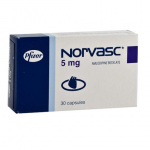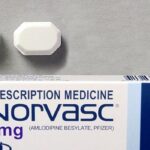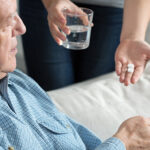Can You Eat Banana While Taking Amlodipine?

Bananas are most commonly known for being a good source of potassium, but as per the U.S. Department of Agriculture’s MyPlate guidelines, their nutritional worth doesn’t end there. In fact, this fruit is packed with a plethora of vitamins and minerals that are essential to your health, making them one of the world’s most appealing superfoods.
According to U.S. Department of Agriculture (USDA) calculations, which are based on a 2,000-calorie diet, a medium-size banana contains only 105 calories. Although it seems obvious that these fruits are a relatively healthy snack, they get a bad reputation because of the large amount of carbohydrates they have: 27 grams (g) for a medium-sized banana.
Bananas are a great food to eat when you’re sick. They’re soft and bland but rich in nutrients and fast-acting carbs. The potassium in bananas can help replenish your electrolyte stores as well since potassium is one of the key electrolytes your body needs.
What is Amlodipine?
Amlodipine is a medication used to treat high blood pressure (hypertension) and certain types of chest pain, known as angina. It belongs to a class of drugs called calcium channel blockers. Amlodipine works by relaxing and widening the blood vessels, which helps to lower blood pressure and improve blood flow, reducing the workload on the heart.
Amlodipine is primarily prescribed to lower high blood pressure. It helps to reduce the force with which the heart pumps blood and relaxes the blood vessels, which results in lower blood pressure. Amlodipine is also used to manage angina, a type of chest pain that occurs when the heart doesn’t receive enough blood and oxygen due to narrowed or constricted coronary arteries. By dilating the arteries, it increases blood flow to the heart muscle and can relieve angina symptoms.
Amlodipine is classified as a calcium channel blocker because it blocks the entry of calcium ions into the smooth muscle cells of blood vessels and the heart. This action helps relax and widen the blood vessels. It is typically taken orally, in the form of tablets or capsules. The dosage and frequency of use will depend on the individual’s condition and the doctor’s prescription.
Can You Eat Banana While Taking Amlodipine?
Eating bananas in moderation while taking Amlodipine is generally safe for most people. Bananas are a healthy fruit that is a good source of potassium, and they can be part of a balanced diet. However, the relationship between Amlodipine and bananas is related to their potassium content.
Amlodipine is a calcium channel blocker medication that helps lower blood pressure by relaxing blood vessels. It doesn’t directly affect potassium levels in the blood. On the other hand, bananas are known for being a good source of potassium, an essential electrolyte that helps maintain proper muscle and nerve function, including the heart.
In some cases, people with high blood pressure may be advised to watch their potassium intake and balance it with their medication. High levels of potassium in the blood can be a concern for people taking certain medications, such as potassium-sparing diuretics or specific ACE inhibitors, but this is less of a concern with Amlodipine.
If you have concerns about your potassium intake while taking Amlodipine, it’s best to discuss it with your healthcare provider. They can provide guidance based on your specific medical history and the overall balance of your diet and medication.
It’s important to maintain a healthy, balanced diet that includes a variety of fruits and vegetables, including bananas, unless your healthcare provider advises otherwise. They can help you make dietary choices that align with your specific health needs and medication regimen.
Always follow your doctor’s advice and ask them any questions you may have about your diet and medication to ensure the best management of your blood pressure and overall health.
Foods To Avoid When Taking Amlodipine
When taking Amlodipine, there are no specific foods that you need to avoid because of the medication itself. However, there are some general dietary guidelines that can help you manage your blood pressure and overall health while taking Amlodipine or any other antihypertensive medication. Here are some dietary considerations:
1. Sodium (Salt): High sodium intake can lead to high blood pressure. To manage your blood pressure, limit your salt intake. This means avoiding highly processed and salty foods, such as fast food, canned soups, and many restaurant dishes. Opt for fresh, whole foods and use herbs and spices for flavoring instead of salt.
2. Potassium: While Amlodipine itself does not affect potassium levels, if your doctor has advised you to limit potassium intake due to another health condition or medication you’re taking, as stated above be mindful of high-potassium foods like bananas, oranges, and potatoes. It’s essential to follow your healthcare provider’s guidance regarding potassium intake.
3. Alcohol: Drinking excessive amounts of alcohol can lead to high blood pressure and interact with your medication. It’s advisable to limit alcohol consumption or follow your doctor’s recommendations regarding alcohol use.
4. Grapefruit: Some medications can interact with grapefruit and its juice, but Amlodipine is not known to interact with grapefruit. However, it’s always a good idea to check with your doctor about any specific dietary restrictions.
5. Caffeine: While caffeine itself does not significantly affect blood pressure, some individuals may be sensitive to its effects. If you notice that caffeine consumption affects your blood pressure or makes you feel jittery, you may want to reduce your intake.
6. Processed and High-Fat Foods: A diet high in processed foods, saturated fats, and trans fats can contribute to high blood pressure and other cardiovascular problems. It’s generally recommended to reduce your intake of these types of foods.
7. Maintain a Balanced Diet: Focus on a balanced diet that includes a variety of fruits, vegetables, whole grains, lean proteins, and healthy fats. A diet rich in fruits and vegetables can provide essential nutrients and fiber that can support heart health.
It’s important to have a discussion with your healthcare provider or a registered dietitian to create a personalized dietary plan based on your specific health needs, any potential interactions with other medications, and your current health status. They can provide guidance on the most suitable dietary choices for you while taking Amlodipine and managing your blood pressure.
What side effects can amlodipine cause?
Along with its needed effects, amlodipine may cause some unwanted effects. Although not all of these side effects may occur, if they do occur they may need medical attention.
Check with your doctor immediately if any of the following side effects occur:
More common
- Swelling of the ankles or feet
Less common
- Chest tightness
- difficult or labored breathing
- dizziness
- fast, irregular, pounding, or racing heartbeat or pulse
- feeling of warmth
- redness of the face, neck, arms, and occasionally, upper chest
Rare
- Black, tarry stools
- bleeding gums
- blistering, peeling, or loosening of the skin
- blood in the urine or stools
- blurred vision
- burning, crawling, itching, numbness, prickling, “pins and needles”, or tingling feelings
- chest pain or discomfort
- chills
- cold and clammy skin
- cold sweats
- confusion
- cough
- dark yellow urine
- diarrhea
- dilated neck veins
- dizziness or lightheadedness when getting up from a lying or sitting position
- extra heartbeats
- fainting
- fever
- itching of the skin
- joint or muscle pain
- large, hive-like swelling on the face, eyelids, lips, tongue, throat, hands, legs, feet, or sex organs
- numbness and tingling of the face, fingers, or toes
- pain in the arms, legs, or lower back, especially pain in the calves or heels upon exertion
- painful or difficult urination
- pale, bluish-colored, or cold hands or feet
- pinpoint red or purple spots on the skin
- red, irritated eyes
- redness of the face, neck, arms, and occasionally, upper chest
- redness, soreness or itching skin
- shakiness in the legs, arms, hands, or feet
- slow or irregular heartbeat
- sore throat
- sores, ulcers, or white spots on the lips or in the mouth
- sores, welting, or blisters
- sudden sweating
- sweating
- swelling of the face, fingers, feet, or lower legs
- swollen glands
- trembling or shaking of the hands or feet
- unsteadiness or awkwardness
- unusual bleeding or bruising
- unusual tiredness or weakness
- weak or absent pulses in the legs
- weakness in the arms, hands, legs, or feet
- weight gain
- yellow eyes or skin
Incidence not known
- Clay-colored stools
- difficulty with speaking
- drooling
- headache
- loss of appetite
- loss of balance control
- muscle trembling, jerking, or stiffness
- nausea
- rash
- shuffling walk
- stomach pain
- twisting movements of the body
- uncontrolled movements, especially of the face, neck, and back
- unpleasant breath odor
- vomiting of blood
- yellow eyes or skin
Some side effects may occur that usually do not need medical attention. These side effects may go away during treatment as your body adjusts to the medicine. Also, your health care professional may be able to tell you about ways to prevent or reduce some of these side effects. Check with your health care professional if any of the following side effects continue or are bothersome or if you have any questions about them:
Less common
- Acid or sour stomach
- belching
- feeling of warmth
- heartburn
- indigestion
- lack or loss of strength
- muscle cramps
- redness of the face, neck, arms, and occasionally, upper chest
- sleepiness or unusual drowsiness
- stomach discomfort, upset, or pain
Rare
- Abnormal dreams
- anxiety
- back pain
- bad unusual or unpleasant (after) taste
- bleeding gums
- blistering, crusting, irritation, itching, or reddening of the skin
- bloating
- bloody nose
- burning feeling in the chest or stomach
- burning while urinating
- burning, dry, or itching eyes
- change in color of the treated skin
- change in sense of smell
- change in taste
- changes in vision
- constipation
- continuing ringing or buzzing or other unexplained noise in the ears
- cracked, dry, or scaly skin
- decreased sexual performance or desire
- depression
- difficulty with moving
- difficulty with swallowing
- discharge, excessive tearing
- double vision
- dry mouth
- dryness of the skin
- excess air or gas in the stomach or intestines
- excessive muscle tone
- eye pain
- feeling of constant movement of self or surroundings
- feeling of unreality
- feeling unusually cold
- flushed, dry skin
- fruit-like breath odor
- full feeling
- general feeling of discomfort or illness
- hair loss or thinning of the hair
- headache, severe and throbbing
- hearing loss
- increased appetite
- increased hunger
- increased sweating
- increased thirst
- increased urge to urinate during the night
- increased urination
- irritability
- irritation in the mouth
- lack of feeling or emotion
- loose stools
- loss of memory
- muscle pains, stiffness, tension, tightness, or weakness
- nervousness
- pain
- pains in the stomach, side, or abdomen, possibly radiating to the back
- passing gas
- problems with memory
- redness and swelling of the gums
- redness, pain, or swelling of the eye, eyelid, or inner lining of the eyelid
- restlessness
- runny nose
- seeing double
- sensation of spinning
- sense of detachment from self or body
- shakiness and unsteady walk
- shivering
- sneezing
- stuffy nose
- sweating
- swollen joints
- tenderness in the stomach area
- thirst
- trouble in holding or releasing urine
- trouble sleeping
- twitching
- uncaring
- unexplained weight loss
- unsteadiness, trembling, or other problems with muscle control or coordination
- waking to urinate at night
- weight loss
Incidence not known
- Swelling of the breasts or breast soreness in both females and males
Other side effects not listed may also occur in some patients. If you notice any other effects, check with your healthcare professional.
Call your doctor for medical advice about side effects. You may report side effects to the FDA at 1-800-FDA-1088.





